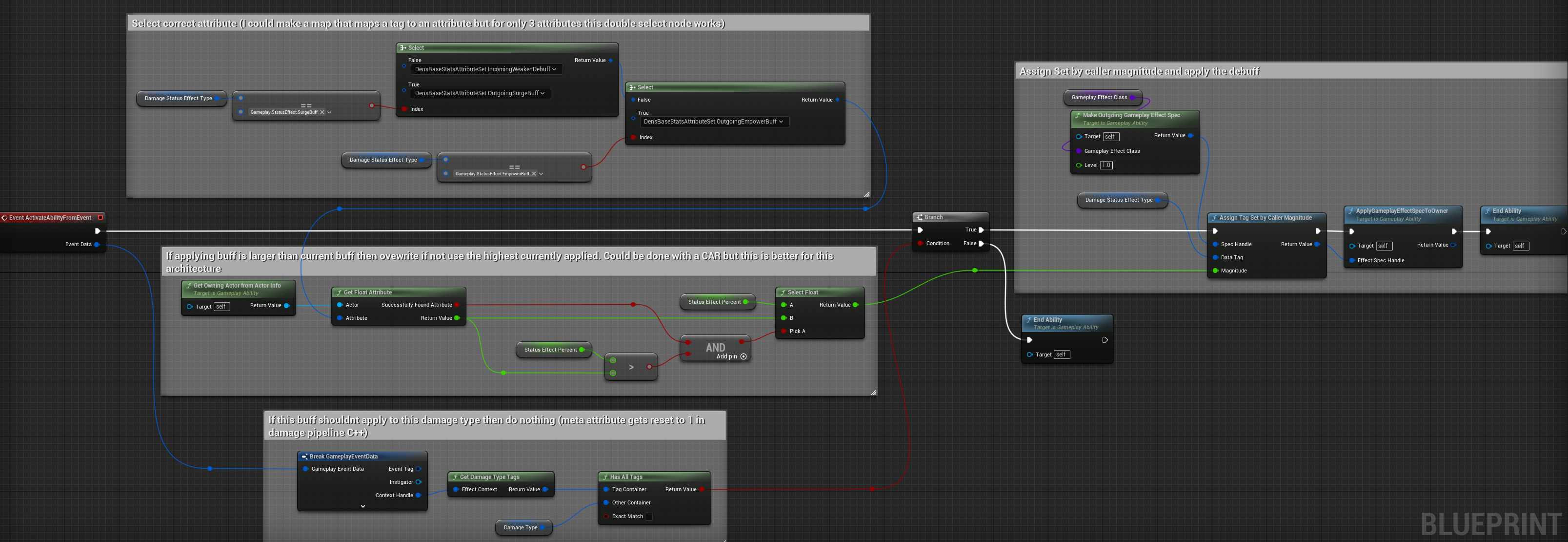Damage pipeline
Extending Unreal Engine's Gameplay Ability System to implement a damage pipeline capable of supporting Destiny 2's complex damage calculations, weapon perks and abilities.
Introduction
This article explores how the damage pipeline used in the project works and how it uses the Gameplay Ability System to do so. It also gives some examples of its use to apply weapon and ability damage with some custom perks and effects found in Destiny 2 such as Rampage and Echo of Undermining vortex grenades.
Buffs, debuffs, weapon perks and damage in Destiny 2
Destiny 2 is a complex first person shooter game that implements many elements from rpg and mmo games. Characters in the game have a wide variety of abilities and weapons and every one of these can have many different perks and modifications that apply effects on the player and enemies from simple stat and damage buffs to crazier effects that heavily alter the players gameplay.
The damage system in Destiny 2 also supports different types of buffs and debuffs some of which stack and some only use the highest effect applied. Weapons and abilities can also deal elemental damage of which there are 3 in Destiny 2 (Arc, Solar and Void). Any of the buffs and debuffs in the game can have the possibility of only affecting a specefic damage type from a specific source, eg: a player could have an effect that gives an increase in damage to Void grenade abilities.
As a general rule however Destiny 2 has 4 main types of buffs/debuffs:
-
Empower effects buff the damage dealt by weapons and only the highest empower buff applied affects the player.
-
Surge effects buff the damage dealt by weapons and are tied to a specific element and only the highest empower buff applied affects the player.
-
Weaken effects increase the damage taken by a target from all sources and only the highest weaken effect applied affects the target.
-
Any other type of damage increase that doesnt belong to the above such as those originating from weapon perks stacks can be stacked infinately.
In order to to simulate this behaviour in UE5, a custom damage pipeline that uses the Gameplay Ability System was created.
GAS Damage pipeline
The damage pipeline is the series of functions and abilities that handle all of the buffs debuffs and effects that can alter the damage dealt by the player’s abilities and weapons. The concept of using a damage pipeline to handle damage in a modular and extensible way was inspired by this excellent post: A Gameplay Framework with GAS based on Risk of Rain 2 by Vitor Cantão in which he reproduces the game Risk of Rain 2’s gameplay systems using GAS.
The damage pipeline created for Density processes all damage using mostly meta-attributes. These are altered by gameplay effects and abilities by responding to gameplay events at different points in the damage pipeline. Each character that can be damaged has the following attributes and meta-attributes (Meta attributes are not replicated and they are manually reset to their base value of 1.0 after each execution of the damage pipeline. See GAS Documentation for more info on meta attributes):
| Attribute | Description |
|---|---|
| Health/MaxHealth | The characters health. When reaching 0 it activates OnKill and OnDeath effects on the instigator and itself respectively |
| Shield/MaxShield | The characters shield. If its > 0 then damage will first apply to the shield before health. On reaching 0 activates OnShieldBroken effects |
| Meta Attribute | Description |
|---|---|
| OutgoingDamage | Base damage of the ability, can be increased by infinitely stacking multipliers in ModifyOutgoingDamage events. |
| OutgoingEmpowerBuff | Separate damage bucket buff. Only the highest applied EmpowerBuff on a character should modify this value ModifyOutgoingDamage events. |
| OutgoingSurgeBuff | Separate damage bucket buff. Only the highest applied SurgeBuff on a character should modify this value in ModifyOutgoingDamage events. |
| IncomingDamage | Initial incoming damage on the target. Usually equal to OutgoingDamage * OutgoingEmpowerBuff * OutgoingSurgeBuff from the instigator. |
| IncomingWeakenDebuff | Amplifies the damage taken. Only the highest debuff should modify this value in ModifyIncomingDamage events. |
| IncomingDamageResistBuff | Any damage resistance buffs that the target has should be multiplied to this value in abilities responding to the ModifyIncomingDamage event. |
| DamageTaken | Damage applied to target, usually equal to IncomingDamage * IncomingWeakenDebuff * IncomingDamageResistBuff. The targets health and shield is reduced in the PostGameplayEffectExecute() function based on this value |
When executing the damage pipeline, the main flowchart of operations is the following:
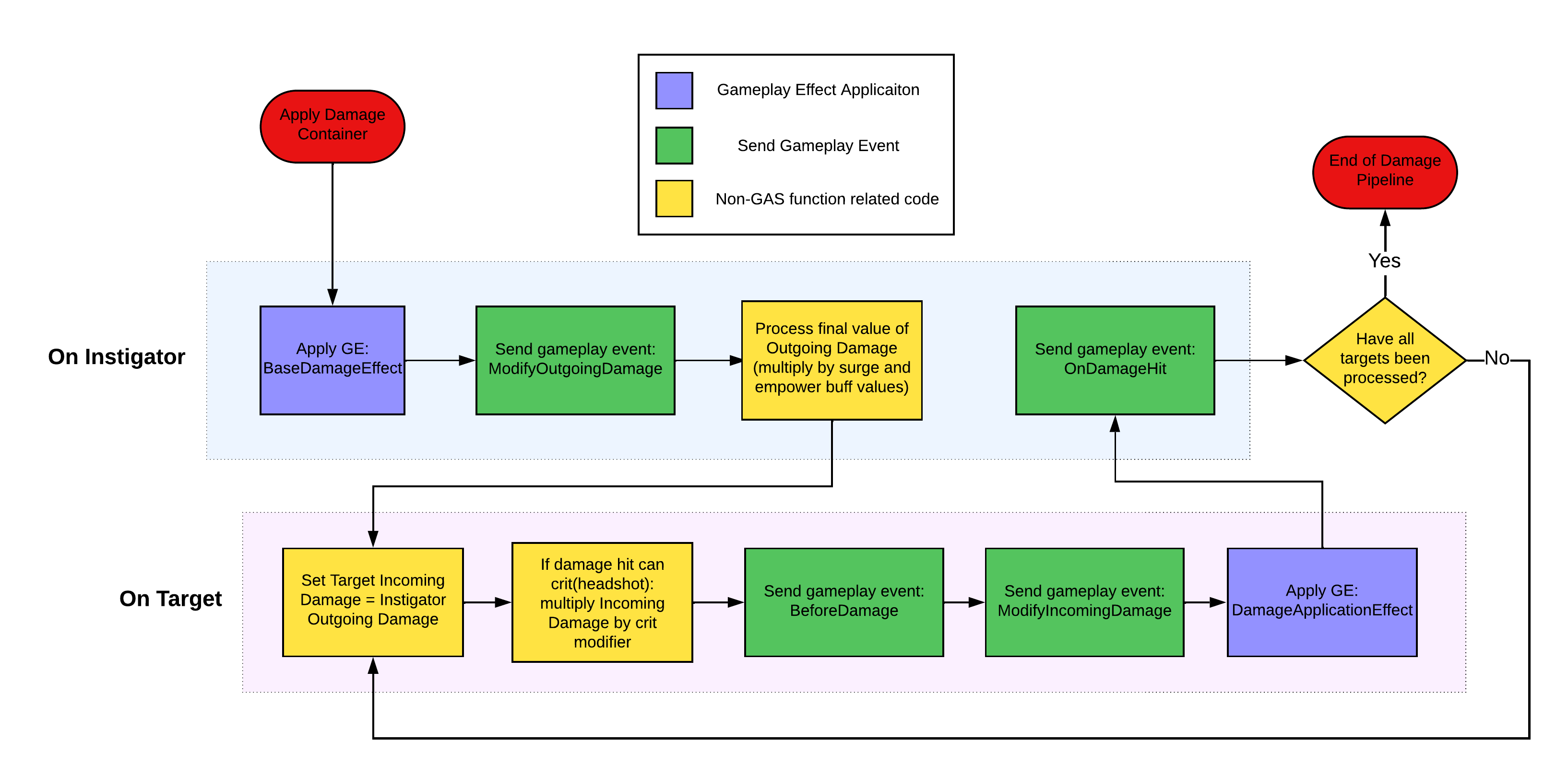
The main steps explained are the following:
- The first step is applying the Damage Container. As explained more in detail below it contains the
BaseDamageEffect, theDamageApplicationEffectand a GameplayTagContainer for the abilitiesDamageType. - The
BaseDamageEffectis applied to the instigator, overriding theOutgoingDamageattribute with the abilitiy’s base damage. - The ModifyOutgoingDamage event is fired on the instigator’s
ASC(Ability System Component). Any ability meant to modifyOutgoingDamage,OutgoingEmpowerBufforOutgoingSurgeBuffshould respond to this event and apply its effects based on the abilitiesDamageTypetags. - Process the
OutgoingDamage,OutgoingEmpowerBufforOutgoingSurgeBuffattributes by multiplying them together, then setting the value as the targetsIncomingDamage. - Modify the incoming damage based on the target data, eg: If the
DamageTypetag is for a weapon and the weapon can critically strike, if the target hit is a weakspot multiply by the weapon’sCritDamageModifierattribute. - The BeforeDamage event is fired on the targets’s
ASC. Any ability meant to apply an effect to the target before damage is calculated should respond to this event and apply its effects based on the abilitiesDamageTypetags. - The ModifyIncomingDamage event is fired on the targets’s
ASC. Any ability that modifies theIncomingDamage,IncomingWeakenDebufforIncomingDamageResistBuffshould respond to this event and apply its effects based on the abilitiesDamageTypetags. - The
DamageApplicationEffectis applied to the target. ThisGEcalculates the final damage and sets the target’sDamageTakenattribute. The PostGameplayEffectExecute() will then handle applying that attribute to the target’sShieldandHealthattributes as well as triggering the OnKill, OnShieldBroken and OnDeath events on the instigator, and targets respectively. - Send the OnHitEffect event on the instigator’s
ASCso that any on-hit abilities can trigger by activating with this event. - If all targets for this container haven’t been processed, go back to step 4.
GAS Damage Container
The concept of damage containers are based on Epic’s Action RPG Sample FGameplayEffectContainer and Vitor Cantão’ post. A damage container provides some quality of life features such as automatically handling the damage pipeline in its entirety and simplifying adding damage to projectile based abilities. Every Gameplay Ability deriving from FDensGameplayAbility has access to the ApplyDamageContainer variety of nodes, which should be used to apply the abilities damage to targets. The FDensDamageContainer class contains:
-
BaseDamageEffectandDamageApplicationEffectclasses which are Gameplay Effects. -
DamageTypeGameplayTagContainer which determines what kind of damage to apply. If for example the damage of a grenade ability has the tagDamageType.Ability.Grenade, this abilities damage will not get increased by effects that buff weapon damage with tagDamageType.Weapon. -
bDamageCanCritboolean determines wether the ability should ever apply a crit modifier buff to the ability. For example most abilities and some weapons in Destiny 2 such as fusion rifles do not receive a bonus for hitting an enemy’s weakspot.
Gameplay abilities derived from FDensGameplayAbility_Damage have a default FDensDamageContainer that can be edited in the class defaults, that gets applied by when calling the ApplyDamageContainer node. However as an example, if one needs to send a damage container to a grenade ability, which applies the damage in a projectile separate from the original ability, a DamageContainerSpec can be created from a container then passed as an argument to the projectile and applied later.
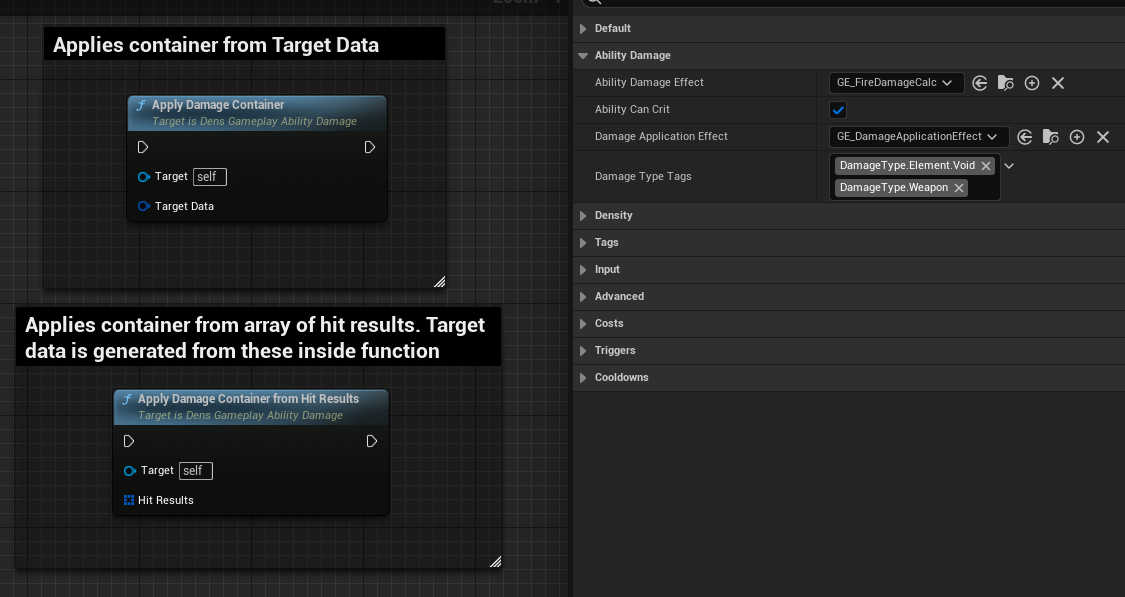

Custom Gameplay Effect Context
In order to send around important data around multiple gamplay abilities such as the abilities DamageType tags, a custom Gamplay Effect Context was used. (Here is a great tutorial on how to do this). The fustom FDensGameplayEffectContext contains a GameplayTagContainer to hold the DamageType tags as well as some other variables such as bIsCriticalHit and bIsCriticalHit which can be used to send information to Gameplay Cues about the damage effect for visual feedback later on.
When firing any of the events in the damage pipeline above, the custom gameplay effect context is also sent along with it in order to be able to access the DamageType tags to check if an effect should apply to a damage type or not.
Example uses of the Damage Pipeline
Rampage weapon perk damage buff example
Rampage is a very popular weapon perk inside of Destiny 2. It is a perk that gives a stacking damage buff when the player defeats an enemy with the weapon that has the perk. The buff lasts for 4.5 seconds and if the user gets another kill within that time the Rampage stacks increase up to a maximum of 3. If the buff timer runs out the stacks reset to 0.
- Rampage x1 gives a 10% damage increase
- Rampage x2 gives a 21% damage increase
- Rampage x3 gives a 33% damage increase
To recreate this using the Density damage pipeline we need two GA, two GE and a curve table to hold the damage increases values for each stack:
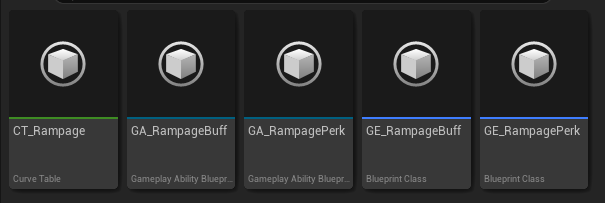
The GA_RampagePerk is added to the player’s ASC when the player equips a weapon that has the perk on its AbiltySet. (The adding of the ability is handled in C++)
The GA_RampagePerk is activated by responding to the OnKill event. Then if the DamageType tag matches DamageType.Weapon, the GE_RampagePerk is applied to the player, the ability then checks the number of stacks of GE_RampagePerk on the ASC and sets the ability level corresponding to the number of stacks.
GE_RampagePerk is an duration based GE that stacks up to 3 times, and lasts 4.5 seconds. It also grants the player the GA_RamageBuff ability. This is the main ability which responds to the ModifyOutgoingDamage event and modifies the OutgoingDamage attribute by applying the GE_RampageBuff effect. The amount by which the OutgoingDamage is multiplied by is extracted from the curve table based on the level of the gameplay effect, which is set to be the same as the ability level set by GA_RampagePerk.
When the player unequips the weapon with the rampage perk, any stacks of GE_RampagePerk remaining on the ASC are removed (this is done in C++).

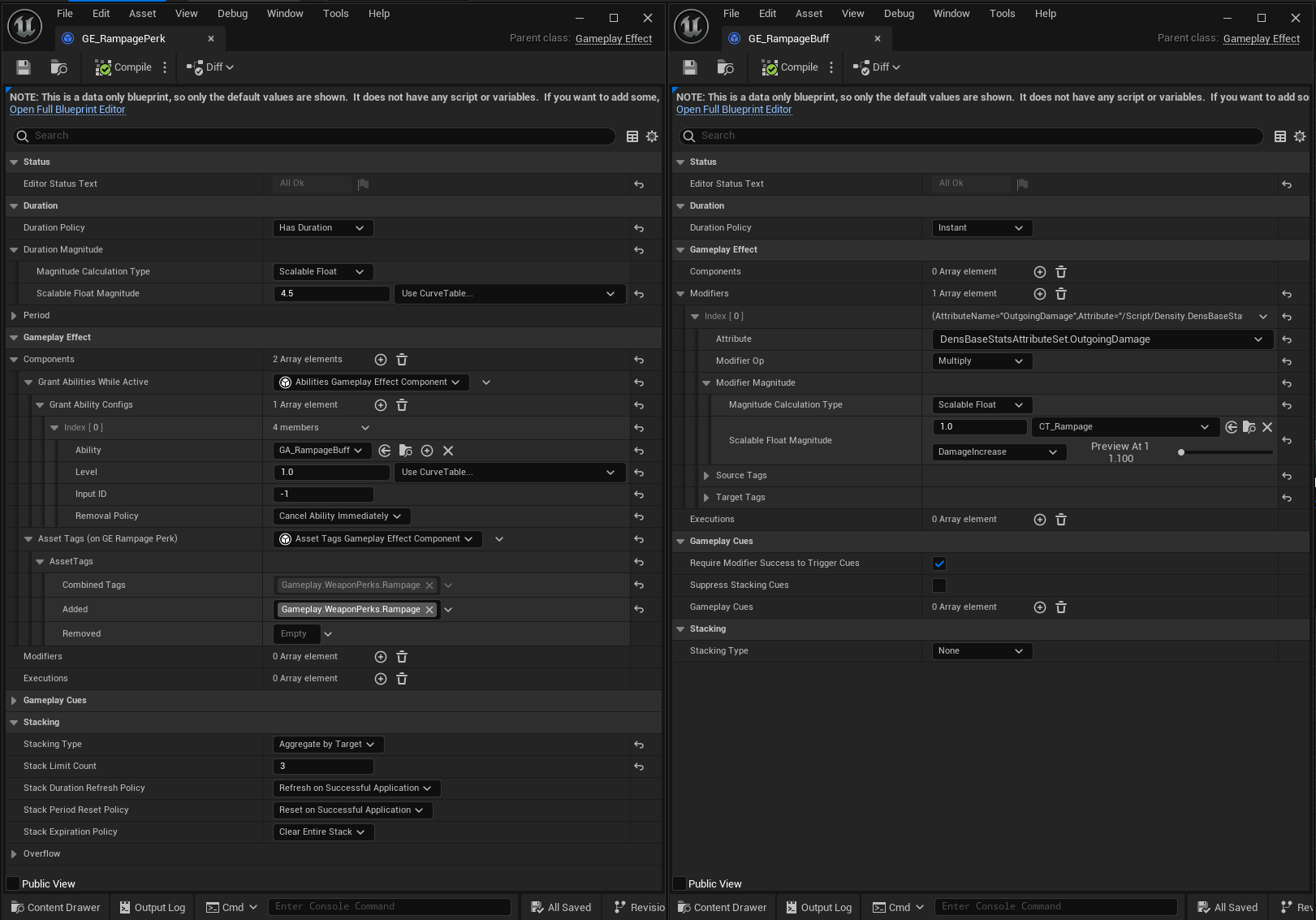
Echo of undermining grenade perk example
In Destiny 2, Echo of Undermining is a fragment(ability) that applies a 15% weaken debuff to an enemy for 5 seconds after a grenade deals damage to it. Weaken debuffs are a type of non-stackable debuff which means that only the highest percent debuff applied should affect a target.
To recreate this using the Density damage pipeline we need two GA and GE. First the ability GA_EchoOfUndermining is added to the player’s ASC. This ability is activated by the BeforeDamage event in the damage pipeline. It is a simple ability, first it checks that the instigator is not the same as the target (so that self damage from a grenade wont apply a weaken effect to the insitgator) and it also checks that the damage being dealth is of tag DamageType.Ability.Grenade. If these conditions are met, the GE_GiveWeaken15Buff is applied to the target for 5 seconds.
GE_GiveWeaken15Buff grants the target the GA_15WeakenDebuff ability while it is applied and also applies the Status.Effects.Weakend tag so that other parts of the game can respond to the target being weakened (such as the HUD damage numbers).
GA_15WeakenDebuff is a data-only gameplay ability that derives from GA_DamageEffect_NonStack, a template ability that was created to handle non-stacking buffs and debuffs (Empower, Surge and Weaken) applied to characters. GA_15WeakenDebuff has the following inputs and the rest is handled by the parent ability:
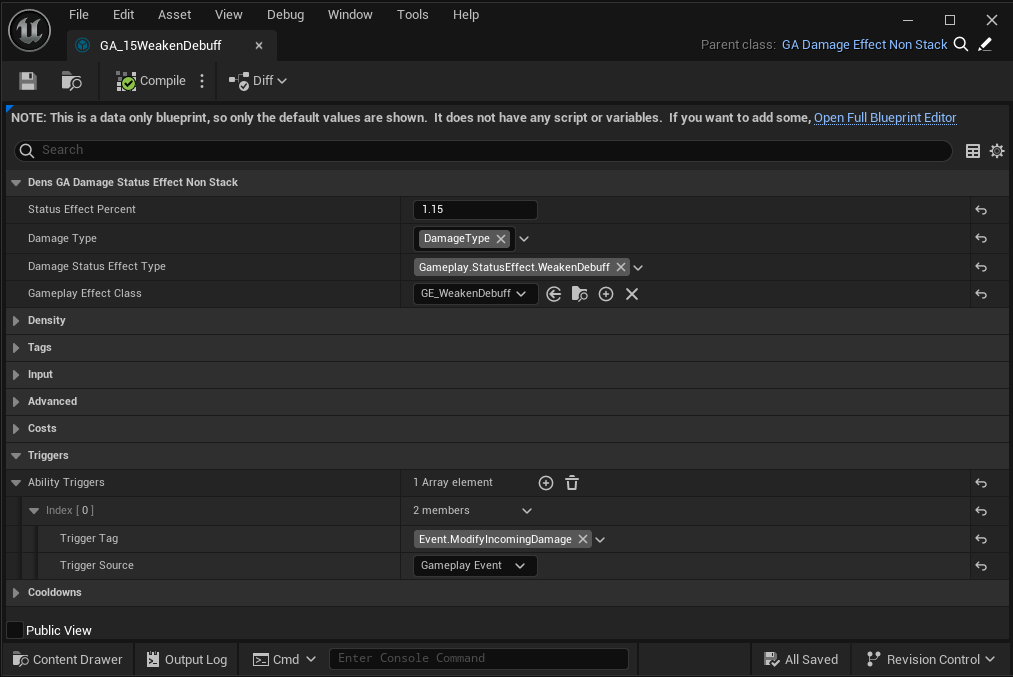
GA_DamageEffect_NonStack first checks the current value of the respective buff attribute (weaken in this case) and then only applies the effect value if the StatusEffectPercent variable is higher than the current attribute value. The value of the applied weaken is set using a SetByCaller magnitude on the GE_WeakenDebuff effect which overrides the value of the IncomingWeakenDebuff attribute.
